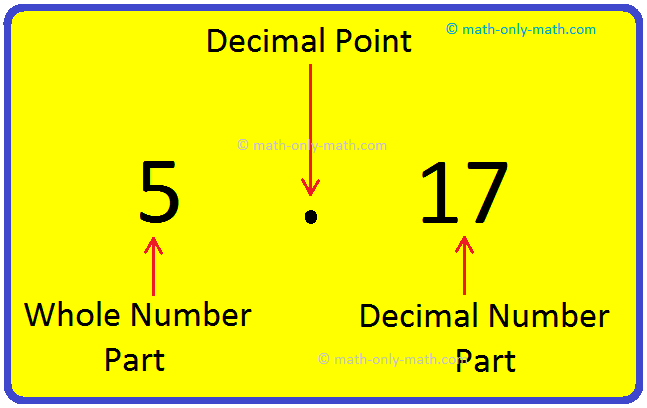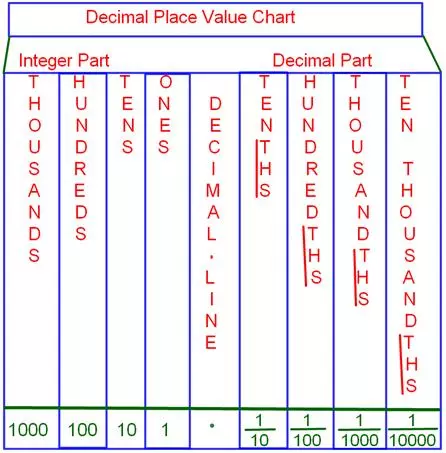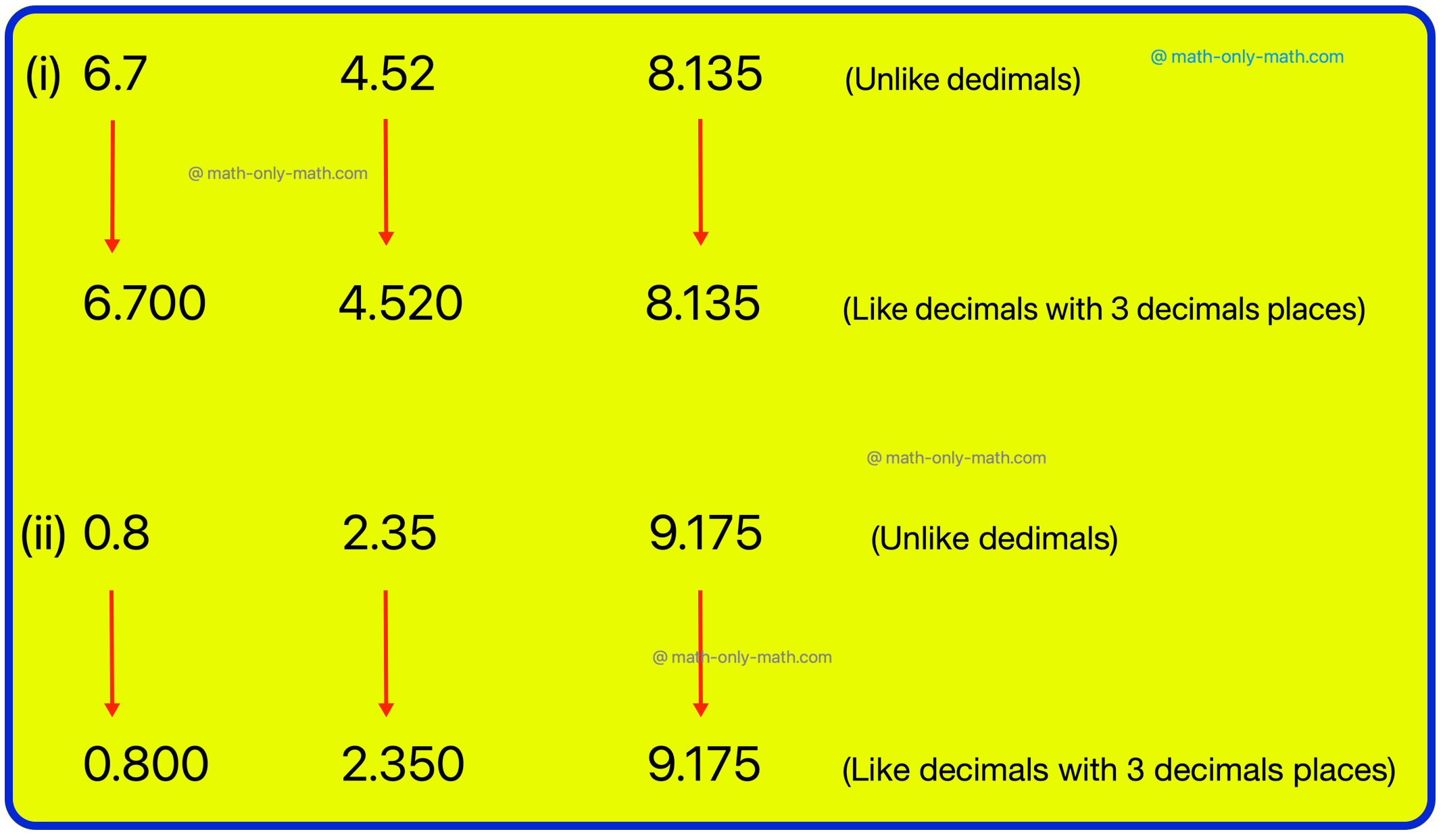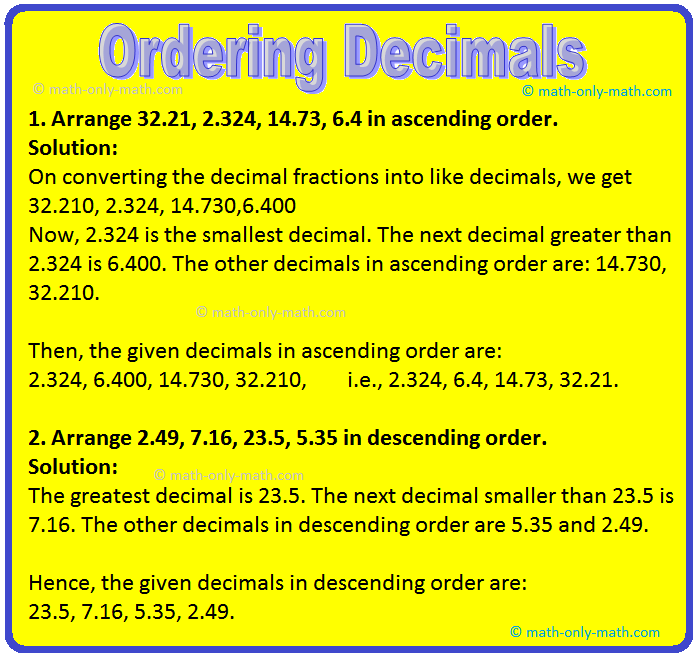Like and Unlike Decimals
Concept of Like and Unlike Decimals:
Decimals having the same number of decimal places are called like decimals i.e., decimals having the same number of digits on the right of the decimal point are known as like decimals. Otherwise, decimals not having the same number of digits on the right of the decimal point are unlike decimals.
Examples on Like and Unlike Decimals:
5.45, 17.04, 272.89, etc. are like decimals as all these decimal numbers are written up to 2 places of decimal.
7.5, 23.16, 31.054, etc. are unlike decimals. As in 7.5 has one decimal place. 23.16 has two decimal places. 31.054 has three decimal places
Note:
If we put any number of annexing zeroes on the right side of the extreme right digit of the decimal part of a number does not alter the value of the number. So, unlike decimals can always be converted into like decimals by annexing required number of zeros on the right side of the extreme right digit in the decimal part.
For example;
9.3, 17.45, 38.105 are unlike decimals. These decimals can be re-written as
9.300, 17.450, 38.105 so now, these are like decimals.
Suppose 0. 1 = 0. 10 = 0. 100 etc, 0.5 = 0.50 = 0.500 etc, and so on. That is
by annexing zeros on the right side of the extreme right digit of the decimal
part of a number does not alter the value of the number.
Unlike decimals may be converted into like decimals by annexing the requisite
number of zeros on the right side of the extreme right digit in the decimal
part.
Definition of Like Decimals:
Two or more decimals having the same number of decimal place are called like decimals.
For example, 0.7, 3.5, 6.1 etc, are a set of like decimals each having 1 decimal place and 2.15, 0.78, 26.11 etc, are like decimals each having 2 decimal places.
Definition of Unlike Decimals:
Two or more decimals having different number of decimal places are called unlike decimals.
For example, 0.8, 4.53, 9.763, 17.856 etc, are unlike decimals.
REMEMBER
The addition of zeros to the extreme right of a decimal part does not change the value of the decimal number, i.e., 2.5 = 2.50 = 2.500 = 2.5000
Such decimals are called equivalent but unlike decimals. Thus, without changing the value of a decimals number, the number of decimal places can be increased simply by adding required number of zeros to extreme right of its decimal part.
● Related Concept
● Decimals
● Conversion of Unlike Decimals to Like Decimals
● Decimal and Fractional Expansion
● Converting Decimals to Fractions
● Converting Fractions to Decimals
● H.C.F. and L.C.M. of Decimals
● Repeating or Recurring Decimal
● BODMAS/PEMDAS Rules - Involving Decimals
● PEMDAS Rules - Involving Integers
● PEMDAS Rules - Involving Decimals
● BODMAS Rules - Involving Integers
● Conversion of Pure Recurring Decimal into Vulgar Fraction
● Conversion of Mixed Recurring Decimals into Vulgar Fractions
● Rounding Decimals to the Nearest Whole Number
● Rounding Decimals to the Nearest Tenths
● Rounding Decimals to the Nearest Hundredths
● Simplify Decimals Involving Addition and Subtraction Decimals
● Multiplying Decimal by a Decimal Number
● Multiplying Decimal by a Whole Number
● Dividing Decimal by a Whole Number
● Dividing Decimal by a Decimal Number
From Like and Unlike Decimals to HOME PAGE
Didn't find what you were looking for? Or want to know more information about Math Only Math. Use this Google Search to find what you need.
Recent Articles
-
Word Problems on Multiplication and Division of Fractions | Worksheet
Apr 12, 25 03:45 AM
word problems on multiplication and division of fractions -
One More than Numbers upto 10 | Counting One More | Learn 1 more Than
Apr 11, 25 04:09 PM
1 more than means we need to add or count one more number to the given numbers. Here, we will learn counting one more than upto number 10. Examples of counting 1 more than up to number 10 are given as… -
One Less than Numbers upto 10 | Counting One Less | Learn 1 Less Than
Apr 11, 25 04:07 PM
What is one less than? 1 less than means we need to subtract or count one less number of the given numbers. Here, we will learn counting one less than upto number 10. Examples of counting 1 less than… -
Properties of Multiplication and Division of Fractions Worksheet | Ans
Apr 10, 25 03:17 PM
In properties of multiplication and division of fractions worksheet you will get different types of questions based on properties of multiplication of fractional numbers and properties of division of… -
Word Problems on Fraction | Math Fraction Word Problems |Fraction Math
Apr 09, 25 01:44 AM
In word problems on fraction we will solve different types of problems on multiplication of fractional numbers and division of fractional numbers.















New! Comments
Have your say about what you just read! Leave me a comment in the box below. Ask a Question or Answer a Question.